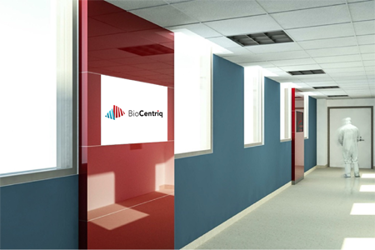New Jersey Solutions For Cell And Gene Development And Manufacturing

By Louis Garguilo, Chief Editor, Outsourced Pharma

New Jersey’s first university-based, cell-and-gene-therapy development and manufacturing innovation center for-hire, was founded on the answers to these questions of the biopharma industry:
- What are your main challenges in manufacturing gene and cell therapy products?
- What are your challenges in recruiting talent?
- What do you need to effectively train your current employees?
Answers poured in pre-establishment of the center from virtual and start-up operations as well as global Big Pharma.
An advisory committee was assembled with professionals from organizations such as Boston Pharmaceuticals, Century Therapeutics, Merck, Novartis, Sartorius, and Spark Therapeutics.
Now BioCentriq, the name given to this non-profit organization under the auspices of the New Jersey Innovation Institute (NJII), itself a part of New Jersey Institute of Technology (NJIT), is open to help biopharma overcome those identified challenges.
Your Challenges As Well?
Chances are Outsourced Pharma readers will recognize this first cell-and-gene need, a topic we’ve closely covered in these pages.
Haro Hartounian, SVP and GM for BioCentriq, learned the overriding challenge in development and manufacturing is viral vector processing.
“Right now,” he says, “viral vector processing remains expensive, time consuming, complex, and the yields are low.”
And that awful sounding equation robs the industry of development opportunities.
“Companies ask if we can help find innovative ways of addressing their scale-up issues while lowering costs,” says Hartounian. “Our answer is yes. For example, with the help of technology developers, we are pursuing continuous processes rather than batch.
“Particularly on the cell-therapy side, processing today is labor intensive and expensive. Everyone is advocating for automation. Broadly speaking, we’re looking at how to improve overall development and manufacturing operations, put companies on the path of operational excellence, and achieve Industry 4.0 technology and connectivity.”

“In New Jersey, for example,” he says, “there are many people who have worked on solid oral dosage forms, or perhaps biological processing, but they have limited experience with cell-therapy.
“If you talk to organizations building major manufacturing facilities around the country, they cannot find talent. In addition, they are trying to retrain their workforce to ensure it can fulfill the advancing requirements of cell-therapy manufacturing specifically.”
Hartounian says his organization has created a workforce development training program, and is already training some of New Jersey’s Big Pharma workers.
One company that’s been collaborating with NJIT is Celgene (now Bristol Myers Squibb). This publically announced relationship is focused on training its workforce in the manufacture of “a new generation of cell therapy technologies to be produced in Celgene’s facilities in Warren and Summit, NJ.”
Hartounian adds: “We’ve launched a master's program in cell and gene therapy sciences. People with a differently focused bachelor’s degree can now get their master's degree at NJIT, and then go to work in these cell and gene therapy disciplines.”
What (Equipment) Is In It For You?
I’ve been reporting on new cell-and-gene support facilities being built around the U.S., and focusing on the specific equipment going into these facilities.
In fact, Hartounian tells me that discussions about equipment led to a fundamental founding precept at BioCentriq.
“The objective is to link industry, academia, regulatory agencies, and technology developers of all sizes to address manufacturing challenges in cell and gene therapy. So we needed an infrastructure plan,” he explains.
“We decided to build facilities to conduct process development, GMP clinical production, and then workforce development and training. The university invested millions of dollars in building a GMP facility and a pilot plant for process development.
“As far as the equipment is concerned, it was clear we needed to stay industry agnostic. We have equipment from various technology developers. We want to ensure if a company or entrepreneur comes to us and says, ‘I developed my process using company X’s bioreactor,’ we will have that equipment.”
Hartounian provided more detail on the equipment for our readers:
- For cell-therapy process development and clinical production (at NJII), Hartounian and team selected a GE FlexFactory cGMP-compliant Cell Therapy manufacturing platform. Under that equipment includes: VIA Thaw dry automated thawer; Sepax C-Pro cell processing system; Xuri W25 Cell Expansion System; and VIA Freeze Duo Controlled-Rate Freezers; Chronicle GMP Manufacturing Automation Software.
- There’s also a Miltenyi ClinicMACS Prodigy closed automated-cell-processing system.
- An array of analytical equipment includes a Beckman Coulter CytoFlex flow cytometer for immuno-phenotyping.
- Specific to gene therapy equipment for process development and clinical production, there’s upstream processing (USP) including shaker flask CO2 incubators for seeding train.
- For adherent cells: iCELLis nano bioreactor for lentivirus and AAV production (PD scale); iCELLIs 500 bioreactor for lentivirus and AAV production (Large scale).
- On the suspension cells side: HEK293T or sf9 insect cells, with an Allegro XRS 25 bioreactor for cell expansion; Allegro STR 50L bioreactor for PD work of AAV and Lentivirus production, and Ambr15 bioreactor for PD of cell and gene therapy project including medium optimization.
- For further downstream processing (DSP): Cadence BioSMB PD System for continuous chromatography, and Cadence Acoustic Wave Separator (AWS) for continuous clarification.
- Analytical equipment includes as a cell counter, Bio-Rad Vi-Cell BLU; Nova BioProfile Flex2 analyzer; for nutrient and metabolite quantitation, pH, dCO2, and dO2 measurement; ddPCR: Bio-Rad QX200 ddPCR system to determine viral titers, host cell DNA, residual plasmid DNA; ELISA and SDS PAGE system for viral protein quantification and host cell protein detection.
The pilot plant for process development has been open since late 2019.
The GMP facility has completed construction, and validation is underway. According to Hartounian, doors will open to initial projects in summer 2020.
A New Kind Of CDMO?
There’s another subject I discussed with Hartounian that will be of great interest to Outsourced Pharma readers.
Actually, it’s a question arising via our coverage of brand-new U.S.-based development and manufacturing service providers being established to meet the needs of the cell and gene therapy industry:
Do “traditional” CDMOs have what it takes to productively and profitably serve the emerging cell and gene arenas? Or are we entering a new era of outsourcing support relationships?
More on that next time.
